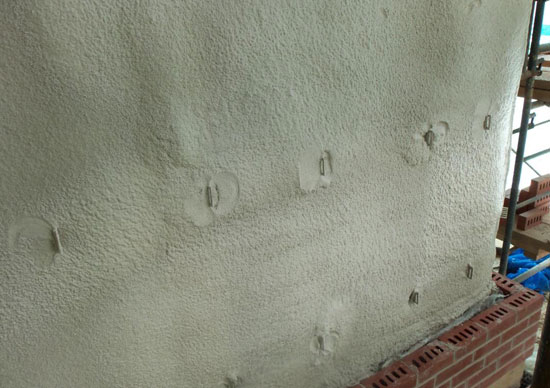Continuous Insulation Systems for Exterior Walls
Air Sealing with Spray Foam Insulation
Unwanted air infiltration in exterior walls is a significant issue in controlling the performance of the building envelope. Studies by the U.S. Department of Energy and others have shown that unwanted air infiltration can be equally significant as the insulating values when it comes to the energy performance of a building. It is not surprising then that the latest version of the International Energy Conservation Construction Code and many energy focused building standards now include this topic as a measure of compliance and performance.
 |
Spray foam insulation can be used to completely fill and seal around brick ties and other irregularities in conventional construction. Photo courtesy of ICYNENE, Inc. |
Traditionally, air sealing in framed wall assemblies has relied on adding an air barrier layer to the outside of the sheathing and taping or otherwise securing the seams. However, these systems are less than perfect when installed, sometimes being subjected to gaps, tears, and incomplete coverage around openings, penetrations, and other irregularities. Using a continuous layer of medium-density closed cell spray foam insulation on the outside of the wall sheathing overcomes these shortcomings. Since the material prevents air from moving through it, everywhere the insulation is placed to deal with heat transfer it also seals up and prevents air transfer. That will include all of those irregular places in a wall where sheet goods may not easily cover. And, since it is continuously sprayed in place, there are no seams or junctions to contend with.
Air sealing within the stud cavities of a wall assembly has often been lacking in traditional construction. Perhaps the biggest performance issue is the use of conventional fibrous batt insulation that has the ability for air to pass through it. While this insulation has been often seen by contractors as a way to “seal up” a wall assembly, it is in fact a misperception. The notion that “stuffing” an opening, gap, or void with fibrous batt insulation will help seal off any air leaks is not accurate. In reality since fibrous insulation allows air to pass through it, putting it in places to seal off air is not effective. Rather, the use of spray foam within a stud cavity, or adjacent irregular spaces and openings, prevents the flow of air in these locations as well. This is an important point in overall wall performance, because not only does an unwanted air flow carry heat with it, it also likely carries water vapor which can condense inside the wall and cause damage. Hence, using a material that truly stops air flow can directly contribute to the long term durability of a wall assembly.
Finally, the use of spray foam insulation in a stud cavity stops convection currents from occurring within that cavity. Those currents are often found in stud cavities with batt insulation and can work against the energy performance of a building by creating an internal thermal air flow that gets past the insulation. This process starts when the wall surface on the warm side of the wall heats up a layer of air adjacent to it inside the stud cavity. That warmed air will rise to the top of the stud space, pulling air from the cooler face through the bottom of the batt insulation toward back toward the warm side. The warm air will then be pulled down along the cool side and give up its heat—effectively transferring heat out the other side of the wall assembly. The overall effect is to by-pass the insulation completely through this circular flow of rising and falling air currents within the cavity. And the principles of physics behind this convective flow don't particularly care what season it is, the process is the same, just on different wall faces. Either way, the amount of energy needed to operate the HVAC system increases due to the poor performance of the wall. Filling the stud cavity fully with spray foam insulation prevents this cycle of rising and falling air currents from happening in the first place and delivers the true performance of the wall that was intended. Even in cases of a partial fill, where the cavity is intentionally not filled up, a wall cavity insulated with foam will be airtight and convection currents will not be able to form since the temperature conditions for their development in the cavity will not likely exist.









